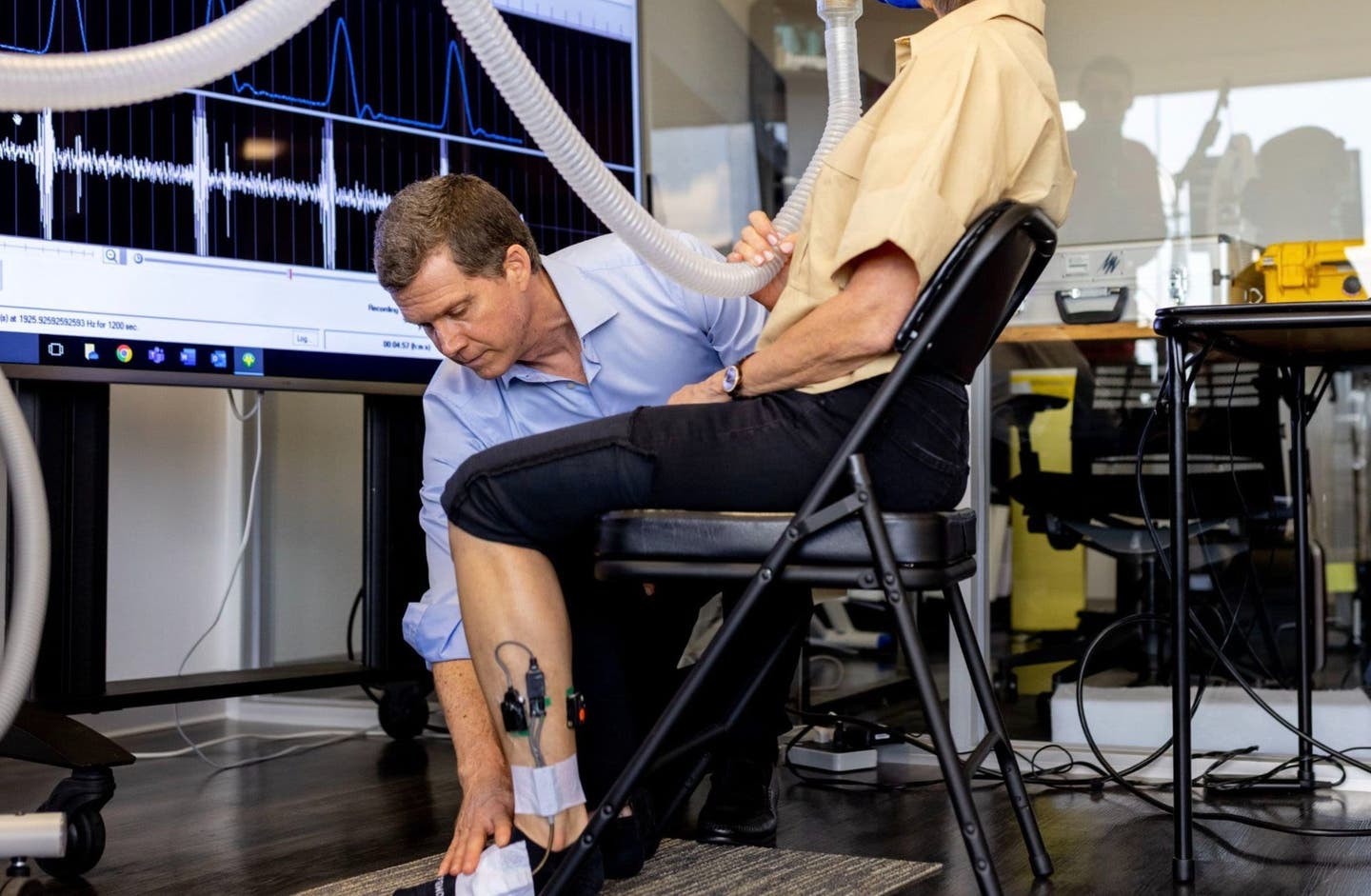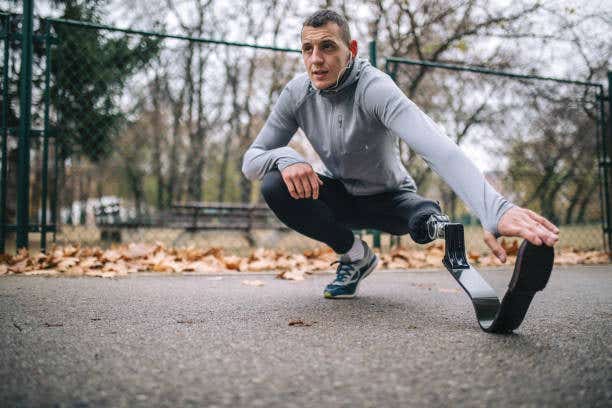Remarkable muscle can turn your body into a fat-burning machine
The soleus muscle, one of the 600 muscles in the human body, is located in the back of the leg located just below the knee to the heel.

[Sept. 14, 2023: Staff Writer, The Brighter Side of News]
Hamilton and his colleagues developed the soleus pushup, which activates the soleus muscle differently than when standing or walking. (CREDIT: University of Houston)
The same researcher who popularized the concept that "sitting too much is not the same as exercising too little" has made a groundbreaking discovery that could revolutionize sedentary lifestyles. According to this research, the soleus muscle in the calf, which only accounts for 1% of the body weight, can significantly improve the metabolic health of the entire body when activated correctly.
Marc Hamilton, a professor of Health and Human Performance at the University of Houston, has found an innovative way to activate the soleus muscle. He has developed the "soleus pushup" (SPU), which can increase muscle metabolism for hours, even when sitting. The soleus muscle, one of the 600 muscles in the human body, is located in the back of the leg and extends from just below the knee to the heel.
According to research published in the iScience journal, the soleus pushup exercise is an effective method for regulating blood glucose levels by sustaining a heightened oxidative metabolism. This method outperforms other popular solutions such as weight loss, exercise, and intermittent fasting. Oxidative metabolism refers to the process of using oxygen to burn substances like blood glucose or fats, which is influenced by the muscle's energy needs during exercise.
The lead researcher, Hamilton, expressed surprise at the soleus muscle's potential. Although it has been present in the body all along, its health optimization capabilities were previously unexplored. When properly activated, the soleus muscle can maintain high levels of local oxidative metabolism for hours rather than just minutes, utilizing a distinct fuel mixture.
Related Stories
According to muscle biopsies, the soleus muscle does not heavily rely on glycogen for fuel. Instead of breaking down glycogen, the muscle uses other sources such as blood glucose and fats. Typically, glycogen is the primary carbohydrate fuel for muscular exercise.
The soleus muscle's reduced dependence on glycogen allows it to work for extended periods without tiring during this type of muscle activity. Glycogen depletion limits muscular endurance, but the soleus muscle's unique metabolic processes optimize it for extended activity. This is the first concerted effort to develop a specialized type of contractile activity focused on optimizing human metabolic processes.
During testing of the SPU, it was observed that the overall impact on blood chemistry resulted in a 52% enhancement in blood glucose (sugar) excursion and a 60% decrease in insulin requirement for up to three hours after consuming a glucose beverage.
The soleus muscle in the calf, though only 1% of your body weight, can do big things to improve the metabolic health in the rest of your body. (CREDIT: University of Houston)
Moreover, the novel approach of maintaining the metabolism of the soleus muscle has proven to be effective in doubling the regular rate of fat metabolism during the fasting period between meals, resulting in a decrease in blood fat levels (VLDL triglyceride).
The Soleus Pushup
Hamilton and his colleagues have created the soleus pushup by building upon years of research. This exercise is designed to activate the soleus muscle in a unique way that is different from when one is standing or walking. The SPU is specifically designed to increase oxygen consumption more effectively than other types of soleus activities, while also being resistant to fatigue.
The Muscular System (Back View). (CREDIT: iStock)
To perform a soleus pushup, one may wonder where to begin. It involves a simple yet effective technique. The exercise can be performed by standing on the edge of a step with the heel hanging off the edge. The individual can then lower the heel towards the ground while keeping the ball of the foot on the step. This motion stretches the calf muscle, and then the individual can push themselves up onto their toes. This movement helps activate the soleus muscle, and the exercise can be repeated to target this muscle effectively.
To activate the soleus muscle differently from standing or walking, Hamilton and his colleagues developed the soleus pushup after conducting extensive research. By increasing oxygen consumption more effectively than other soleus activities, the SPU is designed to be resistant to fatigue.
If you're wondering how to perform this exercise, it involves standing on the edge of a step with the heel hanging off, then lowering the heel towards the ground while keeping the ball of the foot on the step. Pushing up onto the toes completes the motion, effectively targeting the soleus muscle. The aim is to simultaneously shorten the calf muscle while the soleus is naturally activated by its motor neurons.
“The soleus pushup looks simple from the outside, but sometimes what we see with our naked eye isn't the whole story. It’s a very specific movement that right now requires wearable technology and experience to optimize the health benefits,” said Hamilton.
More publications are currently being developed to teach people how to perform this specific movement correctly. However, these upcoming publications won't require the advanced laboratory equipment used in the latest study.
The researchers emphasize that this is not a passing fitness trend or a temporary diet. Instead, it is a powerful physiological movement that takes advantage of the soleus's distinct characteristics.
Potential first step toward a health care breakthrough
According to Hamilton, the discovery made at his Metabolic Innovations lab at UH is the "most important study" to date. This breakthrough could potentially solve several health issues related to prolonged periods of inactivity that lead to low muscle metabolism. The average American spends about 10 hours a day sitting, which further exacerbates these issues.
Study authors pictured left to right: Deborah Hamilton, senior research manager; Marc Hamilton, professor; and Theodore Zderic, research assistant professor. (CREDIT: University of Houston)
Research has found that regardless of an individual's level of physical activity, prolonged sitting increases the risk of various health problems such as heart disease, diabetes, and dementia. More than half of all American adults and 80% of individuals over the age of 65 live with metabolic issues that are caused by either prediabetes or diabetes.
For individuals at high risk of age-related metabolic diseases such as type 2 diabetes and metabolic syndrome, having a low metabolic rate while sitting can be particularly problematic.
Hamilton emphasized that the energy consumption of inactive muscles is often underestimated. He considers this a crucial but frequently overlooked aspect in the search for metabolic remedies to help prevent age-related chronic illnesses.
Although the body's 600 muscles collectively account for only approximately 15% of whole-body oxidative metabolism during the first three hours after carbohydrate ingestion, the soleus muscle, which represents just 1% of the body's weight, can significantly increase its metabolic rate during SPU contractions. This can result in a doubling or even tripling of whole-body carbohydrate oxidation.
Note: Materials provided above by The Brighter Side of News. Content may be edited for style and length.
Like these kind of feel good stories? Get the Brighter Side of News' newsletter.
Joseph Shavit
Head Science News Writer | Communicating Innovation & Discovery
Based in Los Angeles, Joseph Shavit is an accomplished science journalist, head science news writer and co-founder at The Brighter Side of News, where he translates cutting-edge discoveries into compelling stories for a broad audience. With a strong background spanning science, business, product management, media leadership, and entrepreneurship, Joseph brings a unique perspective to science communication. His expertise allows him to uncover the intersection of technological advancements and market potential, shedding light on how groundbreaking research evolves into transformative products and industries.



